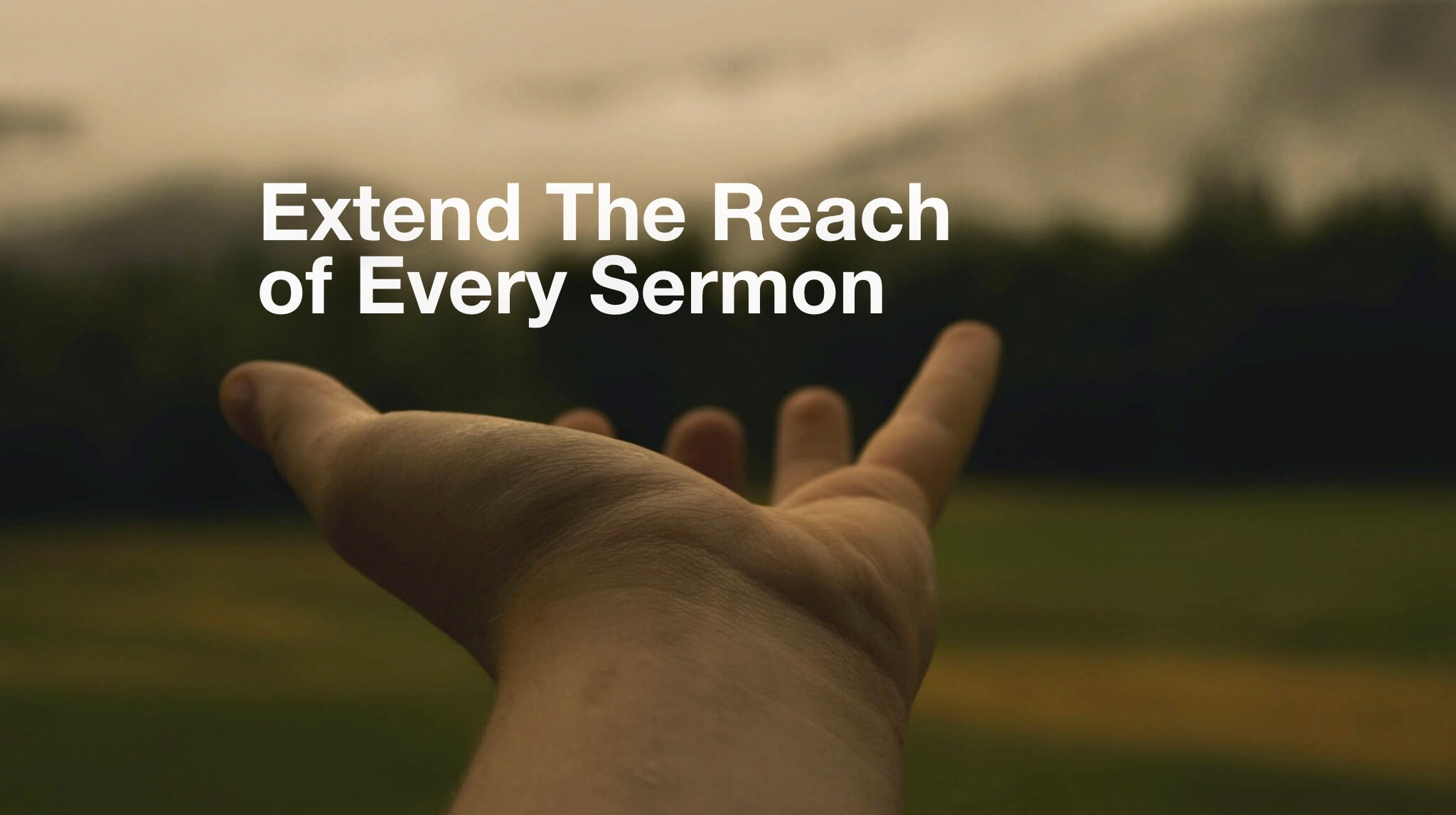10 Ways to Extend the Reach of Every Sermon
Pastors, you spend a lot of time every week working hard on your sermon. So why are we content with letting all that work go to waste?
Today there are a lot of ways that you can take all the work and time that you’re investing and help each sermon live longer and reach more people.
According to various surveys, the average pastor spends 8-15 hours every week working on their sermon. You have to if you want to be a good preacher. The studying, praying, illustrating, rehearsing, and delivering a quality sermon requires time.
But compared to other statistics this investment can appear depressing. Most research says that somewhere within 24 hours people only remember around 25% of what you said. Even worse, within like the next week people only remember around 10% or less.
We spend 8-15 hours every week laboring over a message that has an average lifespan less than the average house fly.
Then that sermon goes into the garbage dump of sermons where all your other sermons go to die, and you’re moving on to the next one.
But your sermon doesn’t have to die young.
Here’s are a few ideas, suggestions, and practical tips to help you see a greater work for the return that you’re already putting into your sermons.
1. Record a video
This one seems obvious because a lot of churches already do this. But if you’re not doing this yet, record your preaching every time.
Get a decent quality camera if you can afford it. If not, use a cell phone.
Then, you can take that message and post it on platforms like YouTube.
YouTube is actually the second largest search engine in the world. Google is number one, and Google owns YouTube.
So you may have noticed that if you ever Google something, suggested videos appear near the top. Those are YouTube videos.
So YouTube videos appear at the top of Google and become easy for people to find.
So if you upload a sermon on a topic that’s helpful to people, you’ve got a better chance of being found by anybody anywhere in the world who might need to hear that message. Suddenly you have a global reach.
Now the key with recording video is using a decent camera if you can. If not, you can use your cell phone. But more important even than the quality of the camera, you need good audio. So make sure you have great audio. The best that you can afford.
There are a lot of soundboards today that will just have an option where you can record whatever’s coming directly in.
If you can’t do that, you can also always just record using a microphone that’s on your camera. I’ll tell you though, if you use the built in microphone it’s going to be cruddy audio. You don’t want that. But you could invest in an onboard microphone for that camera.
If you do that, I recommend using my new favorite microphone, the Deity D3. It’s small enough to mount on the camera and just point and shoot to get good audio. But it’s also a smart microphone, one of the first of its kind. So it can plug into any camera, cellphone, laptop, or just about anything else. It recognizes the device and just works, making it incredibly versatile.
But be warned: In a big room an on-camera mic is not going to be as good because it’s on the camera far away from the speaking on stage. It’ll do the job, but the best option is to record straight out of the soundboard.
I’d recommend picking up a simple external recorder instead, like a Zoom H4N. You can simply plug in an output line from your soundboard into the recorder, press record, and you’re ready to go.
Audio needs to be your number one priority. Nail the audio first, and then you can upgrade your video.
2. Live stream it
Have you ever live-streamed your sermon? It can be as simple as getting out you phone, setting it on a tripod, going on Facebook, and hitting go live. Now you’re live streaming to the world on your church’s Facebook page.
It’s an awesome way for people who sick, in the hospital, or they’re out of town to still be a part of your church community online. It doesn’t replace being there in person, but it’s a nice option to give people.
A lot of churches are already doing this.
To take it to the next level, you can invest in high end streaming software, and use better cameras that plug into a computer. I’d recommend it if you can afford it.
However you do it, your video will reach more people and be saved on your Facebook page so people can watch it anytime. It’s one other way you can use video to make your sermon last longer.
3. Share video clips
Take the long video, your 30-60 minute sermon, and cut out a few highlight clips.
Keep the clips somewhere between 30-60 seconds.
People have short attention spans. A quick video on social media will capture their attention more than if they see a full message. If they see a one hour video, they’ll think, “I don’t have time for that.”
Also, a 60 second video fits within the parameters of most social media platforms. Instagram only allows 60 seconds of video right now. Twitter allows 140.
Plus, social media platforms are pushing video. They’re going to show videos more to people following your page.
So take the highlights of your sermon, and post them. They’re going to get more engagement, more shares, and get found by people searching for those topics.
Now your sermon is still working beyond Sunday.
4. Start a podcast
Churches have been podcasting since long before podcasting was cool.
If you’re capturing high quality audio off of a video, you take the audio, and publish it as a podcast. If your church has a podcast, anybody who’s into podcasts can listen to your entire sermon while at the gym, mowing the lawn, or on the drive to work.
If you want to start a podcast for your church, it can be really intimidating. So let me tell you the easiest way for your church to get started podcasting for free.
Go to anchor.fm. That is the podcast hosting platform that I’ve been using for my brand new podcast. And so far I’m loving it. It’s easy to get started, and it’s free.Other podcast hosting services are going to charge you money every month.
Anchor also makes it easy to submit your show to major podcasting platforms. Your podcasts will be on iTunes, Spotify, Google, and more.
All you have to do then is just pull the audio of your sermon, maybe add a little talking before and after if you want, hit publish, and it’ll go to all podcasting platforms.
Now people can go back and listen to all of your sermons for free any time they want, and your sermon is lasting a lifetime, not just an hour.
Note: That’s exactly what I’m doing. If you watch the video above from my new YouTube channel, I’m took the audio, and turned it into an episode for my podcast. The podcast will be the long form of the audio before I edit it down for the final video.
And that leads to the next point.
5. Publish a blog post
Get your sermon audio transcribed.
Have somebody listen to the sermon, and write the words that you say. Now you’ve got a multiple thousand word article that you can publish on your website as one big article or a handful of smaller articles .
This allows people who want to look up something that you’ve preached, or who like reading more than video or podcasts, to scroll through your church website and read some what you teach.
This will also be a huge boost for your website’s SEO (search engine optimization). The more helpful content that you publish on a website, the more likely search engines like Google are going to direct people searching for content like that to your website.
Blog posts are another way to make your message last a whole lot longer.
Again, I’m practicing what I preach here. This article is an edited form of the transcript of the the video above. I’m making my work count by repurpose the content I’ve created to last longer and to reach more people.
Just know that transcribing a video will take time. A 30-60 minute audio file can take half a workday for somebody to listen and type accurately.
If you’re a manuscript preacher, you’ve already done the written work. You could clean it up and publish your manuscript. But you have more to do than to spend your day transcribing your own sermon.
Look for a volunteer. Find someone in your church that has some time to serve, is good at typing and grammar, and they could serve the church by transcribing the audio from the comfort of their own home.
If you need to get it done quick and professionally, you could also use Rev.com. They’ll have a real human being transcribe your audio or video, with good formatting and grammar.
So get that transcription, and you can post it as a blog post. And then there’s a lot more that you can do with
6. Share quotes
Go over your transcript and pull out some of the highlights, the most powerful statements. Now you have a handful of great quotes to post on social media.
Even better, publish them as images using an app like Word Swag on your phone. I use it to create a lot of my graphics and headlines.
(Here’s my list of recommends iPhone Apps for Pastors).
Just copy and paste your quote into an app like Word Swag, pick a background, and you’ve got a beautiful image that people will share online.
If people in your church like it or comment on it, their friends will see it too. Plus, an image more likely to grab someone’s attention as they’re scrolling through an endless social media feed.
This is going to help your church’s social media reach. Plus it’s going to help your sermon last longer than just Sunday.
7. Publish a book
You can take a sermon series, and turn the transcript of each message into a chapter of a book. If it’s not a full book, you could also make a booklet that you can give out to help people in your church.
Say you preach a great series on how to have a great marriage, going through different parts of the Bible talking about marriage. You can use that and you create a marriage book or booklet for your church.
So when people need marriage counseling, you can hand it to them and say, “Here’s a book. This will help you. It’s what our church teaches about marriage.”
You can take the things that your church is working to teach everybody, put
Consider using something like Kindle Direct Publishing, which is what I use to publish my books. It’s fairly simple to upload your work into Kindle Direct Publishing and have a professional looking paperback book in a few days.
You could even sell it on Amazon, and donate the profit to missions work or your church. Also, it could be a way to work bi-vocationally, using the intellectual property that you’ve already created. Just make sure that you get the approval of your elders before you start selling your sermons.
A book could be a great resource for people and for you. And again, each book is going to last a long time.
8. Discuss it in small groups
Some churches
I’ve also seen many churches take the main points of the sermon and turn it small group questions, or a discussion guide booklet to give to everyone in the group.
This gets everyone in your church on the same page, and thinking about the sermon beyond the weekend.
You’ve already done most of the work. Simply repurpose it and your preaching can become the heart of your church’s small groups.
9. Teach it in classes
One of the churches I worked for took some of the foundational sermons that our senior pastor preached about the mission and the vision of our church, and played snippets of those sermons in their membership classes.
So people who are new to the church and hadn’t heard these big, vision sermons could listen to it for the first time, and get a better understanding of what the church was all about.
It was really helpful, made it easy to have a facilitator teach that class, and allowed the senior pastor to speak to everybody without having to attempt the impossible task of being in each class at multiple locations.
You could also do this for other Sunday school or Bible study classes. If you do a series teaching apologetics, you could use that for an apologetics study, or you could turn a series on the basics of theology into a new believer’s class.
It’s a great way to resource your church and to make sure that everybody’s learning the same things. Plus, your sermon is continuing to live on, educating and helping people grow in their faith.
10. Turn it into a lead magnet
Take a transcript or video that you’re creating and use it as what’s called a lead magnet in the internet marketing world.
A lead magnetic is simply an incentive on your website for people to give you their email address. It’s basically a free download. So if they simply enter their email address you’ll send them a link to a free teaching series, ebook, PDF document, or article.
That download could be your sermon content.
The reason you want an email address is so then you can follow up with them just like you would for a guest to your church because they may have never visited your church before.
I have no idea why churches don’t do this!
You should be capturing email addresses, not just from people showing up at your church, but from people showing up at your church website.
If you can get someone who visits your website to give you an email address for something that they find helpful, first they’re going to find the material you gave them from your sermon incredibly helpful. So you’re already building trust with them, and they’re starting to like what your church offers if they like what you’ve give them.
Second, now you can follow up with them and send them more information about your church, different things going, and invite them to come back or visit for the first time.
You never know what God could do with a few simple emails.
For an example of this, just scroll down and you can see the one that I use for this site. I offer a free download for emails first because I want to help you, and second because I would love to continue sending you helpful updates about new content and resources I’m creating. It’s one simple way that has helped me grow my email list from nothing to thousands of pastors around the world.
So don’t let your sermon die young. Your preaching can last so much longer than Sunday.
Get some people to help you so you’re not doing it all yourself, and you can take all that hard work that you’re already doing and get so much more out of it.





This is so helpful.
Please add a Print Friendly button/link to these.